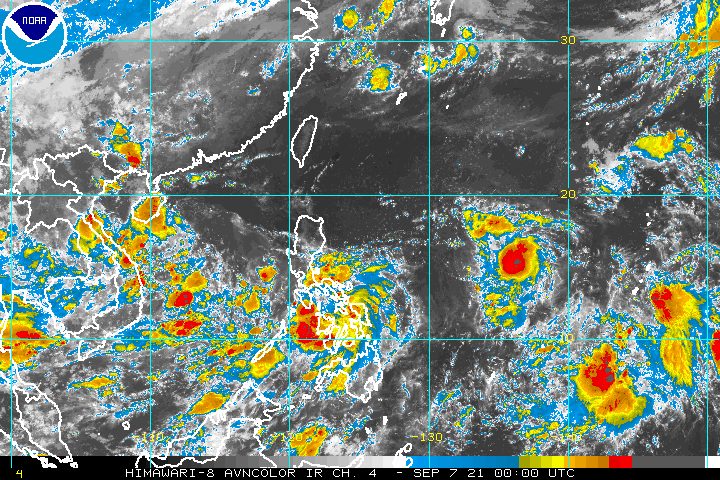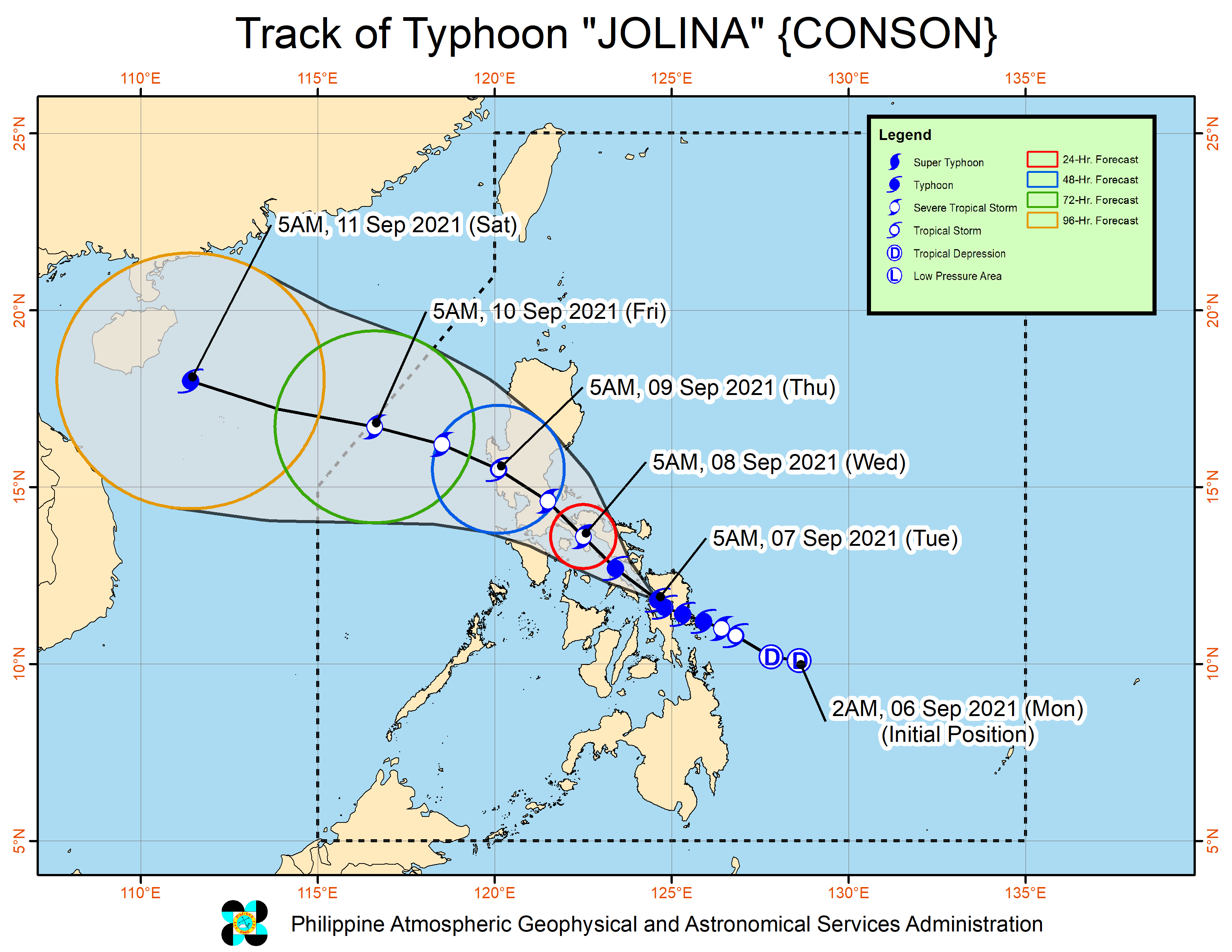SUMMARY
This is AI generated summarization, which may have errors. For context, always refer to the full article.

Typhoon Jolina (Conson) made its fourth landfall in Almagro, Samar, at 6:30 am on Tuesday, September 7, and proceeded to move toward Masbate.
The typhoon’s landfalls, so far, have been in the following areas:
- Hernani, Eastern Samar – 10 pm, Monday, September 6
- Daram, Samar – 2 am, Tuesday, September 7
- Santo Niño, Samar – 3:40 am, Tuesday, September 7
- Almagro, Samar – 6:30 am, Tuesday, September 7
In a bulletin released past 8 am on Tuesday, the Philippine Atmospheric, Geophysical, and Astronomical Services Administration (PAGASA) said Jolina was already over the coastal waters of Almagro, or over the Samar Sea.
The typhoon slightly slowed down, moving west northwest at 15 kilometers per hour from the previous 20 km/h.
It continues to have maximum sustained winds of 120 km/h, while its gustiness is up to 150 km/h.
While Signal No. 1 has been lifted in a few areas, some places like Metro Manila and Cavite have been added to the list as of 8 am on Tuesday.
Signal No. 3 (destructive typhoon-force winds)
- northern and eastern parts of Masbate (Pio V. Corpuz, Palanas, Cataingan, Placer, Dimasalang, Uson, Cawayan, Esperanza, Mobo, Aroroy, Baleno, Masbate City, Mandaon, Milagros) including Ticao and Burias Islands
- extreme western part of Northern Samar (San Vicente, Capul, San Isidro, San Antonio)
- northern part of Biliran (Kawayan, Maripipi, Almeria)
- northwestern part of Samar (Santo Niño, Tagapul-an, Almagro, Calbayog City)
Signal No. 2 (damaging gale-force to storm-force winds)
- Albay
- Sorsogon
- rest of Masbate
- western and southern parts of Camarines Sur (Del Gallego, Lupi, Ragay, Libmanan, Sipocot, Cabusao, Pasacao, Pamplona, Gainza, Camaligan, Canaman, Magarao, Bombon, Naga City, Pili, Ocampo, Iriga City, Sagñay, Buhi, Milaor, San Fernando, Minalabac, Bula, Nabua, Baao, Balatan, Bato, Calabanga)
- western part of Camarines Norte (Capalonga, Jose Panganiban, Labo, San Vicente, San Lorenzo Ruiz, Santa Elena)
- Marinduque
- southern part of Quezon (Tagkawayan, Guinayangan, Buenavista, Mulanay, San Narciso, San Francisco, San Andres, Catanauan, Calauag, General Luna, Lopez, Macalelon, Perez, Alabat, Quezon, Atimonan, Padre Burgos, Agdangan, Unisan, Pitogo, Gumaca, Plaridel)
- eastern part of Romblon (San Fernando, Magdiwang, Cajidiocan, Romblon, Banton, Corcuera)
- rest of Biliran
- western part of Northern Samar (Silvino Lobos, Lope de Vega, Catarman, Bobon, San Jose, Rosario, Lavezares, Biri, Allen, Victoria, Mondragon)
- rest of Samar
- northern part of Leyte (Calubian, San Isidro, Tabango, Leyte, Villaba, Matag-ob, Kananga, Carigara, Jaro, Pastrana, Santa Fe, Tacloban City, Barugo, San Miguel, Alangalang, Tunga, Babatngon, Capoocan)
Signal No. 1 (strong winds with occasional gusts)
- Catanduanes
- rest of Camarines Sur
- rest of Camarines Norte
- rest of Quezon including Polillo Islands
- Laguna
- Cavite
- Batangas
- Metro Manila
- Bulacan
- rest of Romblon
- Oriental Mindoro
- rest of Northern Samar
- rest of Eastern Samar
- rest of Leyte
- northern part of Southern Leyte (Silago, Bontoc, Sogod)
- northern part of Cebu (Carmen, Tuburan, Catmon, Sogod, Tabuelan, Borbon, Tabogon, San Remigio, Bogo City, Medellin, Daanbantayan) including Camotes and Bantayan Islands
- northeastern part of Iloilo (Concepcion, Sara, San Dionisio, Batad, Estancia, Carles, Balasan)
- northern part of Aklan (Malay, Nabas, Ibajay, Tangalan, Makato, Numancia, Lezo, New Washington, Kalibo, Batan, Altavas)
- northern part of Capiz (Pilar, Panay, Roxas City, Sapi-an, Ivisan, Pontevedra, Panitan, President Roxas, Ma-ayon)
Jolina will continue to trigger rain on Tuesday, mainly in Eastern Visayas, Bicol, and Mimaropa. Affected areas were advised to stay on alert for scattered to widespread floods and landslides.
Heavy to intense rain, with at times torrential rain
- Northern Samar
- Eastern Samar
- Samar
- Leyte
- Biliran
- Sorsogon
- Albay
- Masbate
- Romblon
Moderate to heavy rain, with at times intense rain
- rest of Visayas
- rest of Bicol
- southern part of Quezon
- Occidental Mindoro
- Oriental Mindoro
- Marinduque
PAGASA also said early Tuesday morning that in the next 24 hours, storm surges 0.5 to 1 meter high may hit coastal areas in these provinces:
- Biliran
- Sorsogon
- Samar
- Masbate
Storm surges would “pose a threat to life and property,” warned the state weather bureau.
“In addition, coastal areas of localities under [tropical cyclone wind signals], especially those at No. 2 and No. 3, may experience coastal flooding due to hazardous surf conditions,” PAGASA said.
Jolina also continues to affect coastal waters on Tuesday.
Rough to very rough seas (waves 2.5 to 5 meters high)
Travel risky for all vessels, inexperienced mariners should seek safe harbor
- seaboards of areas under Signal Nos. 2 and 3
Moderate to rough seas (waves 1.2 to 2.8 meters high)
Small vessels must take precautionary measures, inexperienced mariners should avoid navigation
- seaboards of areas under Signal No. 1
- remaining seaboards of Visayas
- northern and eastern seaboards of Mindanao
Jolina’s fifth landfall could be in Masbate, either in the mainland or in Ticao Island, also on Tuesday.
After that, the typhoon could head northwest toward Burias Island and the Ragay Gulf, then make another landfall in the southeastern part of Quezon on Tuesday evening or early Wednesday morning, September 8. As it crosses land, it may also weaken into a severe tropical storm.
By Wednesday afternoon, Jolina could emerge over Lopez Bay, then make yet another landfall in the northern part of Quezon.
It will cross Central Luzon for the rest of Wednesday until Thursday morning, September 9, which would be to the east and north of Metro Manila. During this time, it may weaken into a tropical storm.
Finally, Jolina could emerge over the West Philippine Sea before noon on Thursday. It may regain strength beginning Thursday afternoon as it heads for the southern China-northern Vietnam area.
It is likely to leave the Philippine Area of Responsibility (PAR) on Friday morning, September 10.

Aside from Jolina, another tropical cyclone is expected to enter PAR on Wednesday morning, to be given the local name Kiko.
It was still a tropical depression before dawn on Tuesday, but it may intensify before entering PAR.
It was last spotted 1,685 kilometers east of Central Luzon.
PAGASA said the chances of landfall are slim, but a tropical cyclone wind signal may be raised for Batanes if the potential Kiko goes near the province. (READ: FAST FACTS: Tropical cyclones, rainfall advisories)

Jolina is the Philippines’ 10th tropical cyclone for 2021 and the first for September. Kiko would be the 11th for the year.
For the next six months, these are PAGASA’s estimates for the number of tropical cyclones inside PAR:
2021
- September – 2 or 3
- October – 2 or 3
- November – 2 or 3
- December – 1 or 2
2022
- January – 0 or 1
- February – 0 or 1
An average of 20 tropical cyclones form within or enter PAR each year. (READ: LIST: PAGASA’s names for tropical cyclones in 2021) – Rappler.com
Add a comment
How does this make you feel?




There are no comments yet. Add your comment to start the conversation.